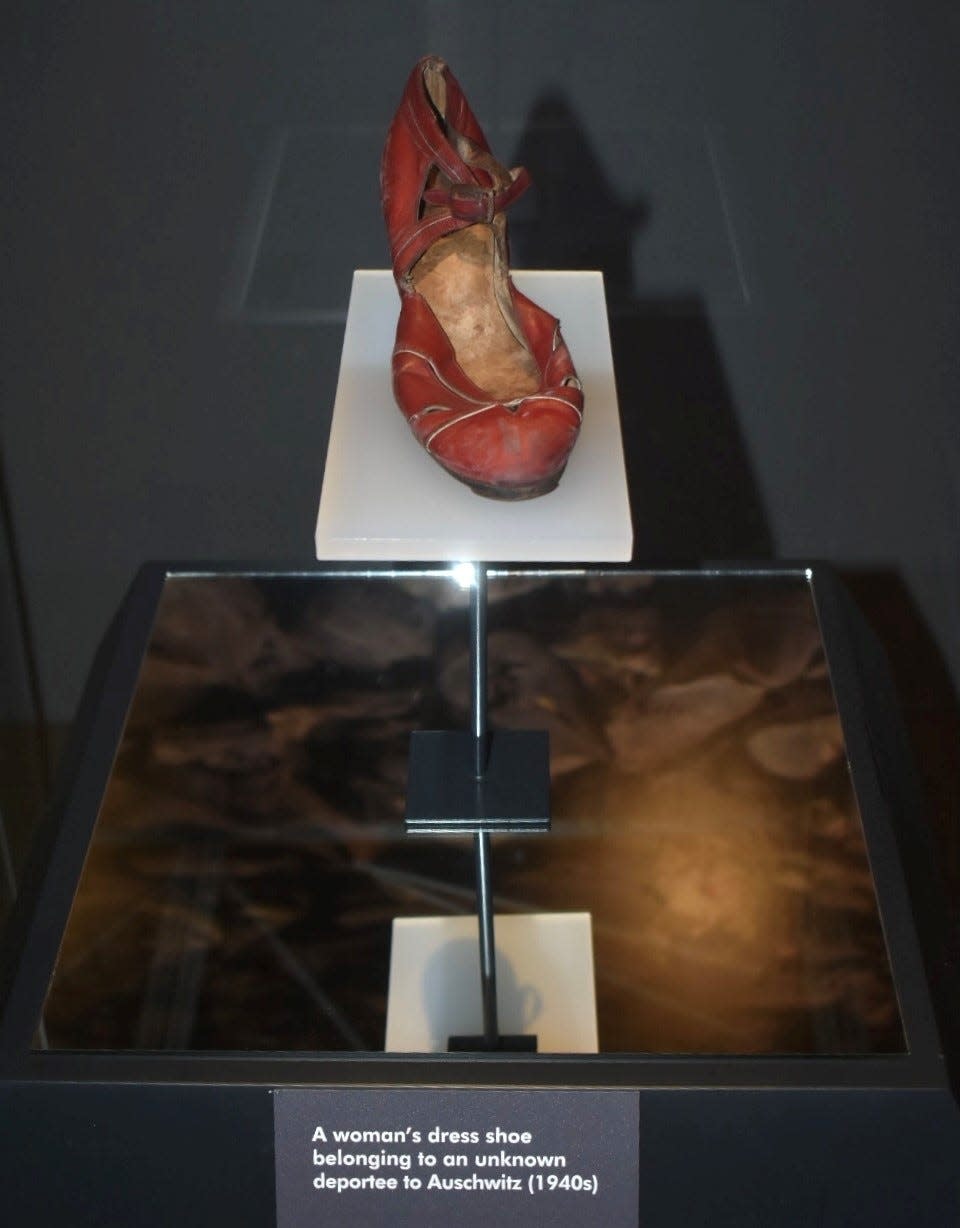Hearing the silence: Auschwitz exhibit makes West Coast debut in Simi Valley
- Oops!Something went wrong.Please try again later.
The red, leather-strapped dress shoe was worn by a woman who was sent to Auschwitz and within hours likely became one of the camp's 1.1 million fatalities. Her belongings were almost certainly thrown into a growing pile.
The shoe is among the more than 700 artifacts from Auschwitz and other Holocaust sites displayed in an exhibit that opens Friday and is the largest ever at the Ronald Reagan Presidential Library & Museum in Simi Valley.
Its name carries meaning, “Auschwitz. Not long ago. Not far away.”
Sprawled over 12,500 square feet, the exhibit tells of the pain and death of the largest and most lethal of the World War II concentration camps.
A Jewish prayer shawl – fringed and decorated in black, gray and white – was once worn by Simon Krieser. He lived in Belgium before fleeing to France, and made a living selling clothes made by his wife, Perla. Just before they were deported to Auschwitz and killed, Krieser sent his scant savings and his tallit shawl to his daughters.
On another wall in the exhibit is a drawing used by the Nazis as a how-to guide for executing Jews. It shows soldiers firing their guns at just the right distance from their victims so the bodies fell back into a deep pit.

Many of the objects came from the Auschwitz-Birkenau State Museum, on the site of the concentration camp near Oswiecim, Poland. The 5-year-old exhibit is touring the world in a series of long stops. It’s highly promoted stay at the Reagan library for the next five months is its first and only West Coast appearance.
Friday’s opening is already sold out. More than 26,000 advance tickets have been sold for the Reagan stay. Museum leaders said people who want to attend should order tickets in advance. They should also be prepared for a haunting look at pain, death and horror that will likely leave them quiet.
“You hear the silence,” said Luis Ferreiro, director of Musealia, the Spanish company that created the exhibit in concert with the Auschwitz-Birkenau museum. He said the goal is to show not only what happened but how it happened.
“You cannot just look at this story and turn the page,” he said.
The exhibit is immense. It includes a German-made railroad car built before World War II – the kind used to transport Jews to their deaths at concentration camps.
A small part of an Auschwitz barracks is on display too, as is a model of the device used to flood execution rooms with gas. A ballot from Germany’s parliamentary election in 1936 shows Adolf Hitler's name in huge letters and, in smaller letters, the names of other Nazi leaders, including Hitler's loyal supporter, Hermann Göring. Voters were given no other choices.
“Every time I walk through here, I feel a heavy weight in my chest,” said Ronald Regan Presidential Foundation & Institute spokeswoman Melissa Giller, stopping to explain a display of belongings taken from people when they were imprisoned at the camp. Many of the items were then used by the captors.
“If it was a beautiful silk top, the SS commander might take it to his wife,” she said of the Schutzstaffel, the Nazi paramilitary group that oversaw the camps.
Giller first learned of the exhibit six years ago, before it started touring. Months later, she was in Madrid talking to the creators about bringing it to the Reagan library.
At least 10,000 school children, maybe more, will tour the exhibit over the next several months. Starting in early April, Holocaust survivors will speak at the exhibit. It is education aimed at reinforcing the message and title. The Holocaust wasn’t that far away or that long ago.
“I think the further we move away from the moment in time, the more likely it will become forgotten,” said John Heubusch, retiring director of the Reagan Foundation. He worries about a growing us versus them mentality. It likely won’t lead back to Auschwitz but the ultimate destination won't be good, he said.
“I do think all of this hatred and division over race is the first step that can lead to terrible things we need to avoid at all costs,” Heubusch said. He emphasized the importance of the Auschwitz artifacts and photos.
“It’s our most impactful exhibit ever,” he said.
Gordon Sondland, former amabassador to the European Union, worries about people who downplay the concentration camps and genocide, falsely claiming the number of Jews killed has been exaggerated. His parents were both Holocaust survivors. His mother fled Berlin to Uruguay with her family. His father was smuggled out of Germany and joined the French Foreign Legion. He fought in the war and spent a year in a prisoner of war camp in Africa.
Sondland, who made news by testifying in Donald Trump’s first impeachment proceedings, helped underwrite the Auschwitz exhibit with a large donation to the Reagan Foundation. He wants people to understand the Holocaust emerged not just because of Nazi leaders but through the actions and support of the people of Germany.
“It was the average citizen who was drafted into this. You say, ‘Could my neighbor participate in something like this and yes, they did,” he said.
General adult admission to the exhibit is $32.95, including an audio tour. Tickets can be purchased online at https://www.reaganfoundation.org/library-museum/online-ticket-sales/. For more information, call 805-577-4066.
Tom Kisken covers health care and other news for the Ventura County Star. Reach him at tom.kisken@vcstar.com or 805-437-0255.
SUPPORT LOCAL JOURNALISM: To see more stories like this, subscribe here.
This article originally appeared on Ventura County Star: Ronald Reagan Library opens Auschwitz exhibit in Simi Valley Friday

